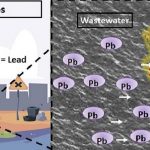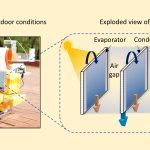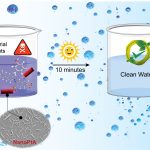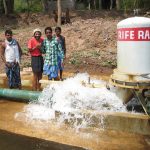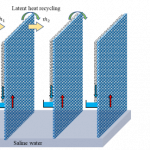System installed in a remote Karnataka village school has helped reuse large amounts of greywater

(Photo courtesy: Plasma lab, CST, IISc)
Researchers at the Centre for Sustainable Technologies (CST) have developed an efficient decentralised wastewater treatment and recycling system at a primary school in the remote village of Berambadi in Karnataka.
A new study shows how the system has, over the past year, enabled the reuse of wastewater and reduced dependence on freshwater resources. “We have demonstrated for the first time that decentralised wastewater treatment systems can be economically put into practice in a rural setting,” says Lakshminarayana Rao, Assistant Professor at CST and a senior author of the paper published in the Journal of Water Process Engineering.
The research team operated the greywater treatment system for a year and monitored different characteristics at the entry and exit points. The performance of every treatment stage was quantified in terms of removal efficiencies (REs) of turbidity, Total Suspended Solids, nitrate, total phosphorus, Biological Oxygen Demand, Chemical Oxygen Demand and faecal coliforms. Overall, the system showed high REs – more than 90% for most of the parameters. About 667 litres of greywater was treated daily using the system, saving around 1,80,000 litres of water annually.
At Berambadi Primary School, greywater is produced at the hand wash and kitchen wash mostly during the lunch hours. The treatment system first passes the greywater from the hand wash sinks through strainers that screen out large food particles from water. “Then, the water goes through three anaerobic sand biofilters – tanks filled with locally available coarse gravel, medium gravel and sand, where bacterial biofilms help in the breakdown of nutrients in greywater to reduce nutrient levels of water,” explains PS Ganesh Subramanian, a former Project Assistant at CST and the first author of the paper.
The greywater from the kitchen sinks, on the other hand, is first passed through a grease trap to strip off the top layer of oil and grease from water. After this, water flows through an anaerobic sludge bioreactor followed by a stratified biofiltration chamber. Finally, the filtered water from both hand wash sinks and kitchen sinks enters an aeration tank followed by an ozonation tank, where it is treated with ozone for disinfection.
The ozone is generated using a cold plasma ozonator designed specifically for disinfection of wastewater. “Ozonation removes odours and colours from water, and eliminates faecal coliforms, thereby disinfecting the water while leaving no harmful by-products. [It also] enhances the Dissolved Oxygen concentration of the water,” explains Subramanian. The treated water stored in an overhead tank is then readily available for reuse by the students and staff of the school for domestic non-potable purposes such as toilet flushing and gardening.
“Here, plasma technology is used to create a high throughput solar powered ozonator for cleaning up the water effectively,” says Rao. The ozonator used in the system works with ambient air as the input gas – instead of oxygen – to generate ozone. “This completely eliminates the need for hazardous oxygen cylinders, thus allowing the system to be easily operated and maintained by the staff at the school,” he says.
The authors suggest that a robust wastewater management system like this can be replicated in both rural and urban settings after taking into consideration factors such as space limitations, baseline greywater quality and daily flowrates. “The people from Berambadi village are very happy with the system. Based on the success of this sustainable wastewater management project, several other schools in Karnataka have approached us to duplicate it in their schools,” says Rao.
The study was carried out in collaboration with the Ashoka Trust for Research in Ecology and the Environment, and the University of Glasgow and James Hutton Institute in the UK.

